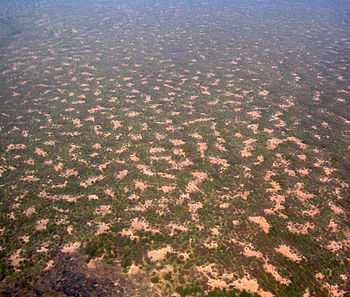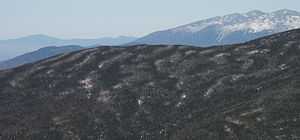Patterned vegetation



Patterned vegetation is a vegetation community that exhibits distinctive and repetitive patterns. Examples of patterned vegetation include fir waves, tiger bush, and string bog. The patterns typically arise from an interplay of phenomena that differentially encourage plant growth or mortality. A coherent pattern arises because there is a strong directional component to these phenomena, such as wind in the case of fir waves, or surface runoff in the case of tiger bush. The regular patterning of some types of vegetation is a striking feature of some landscapes. Patterns can include relatively evenly spaced patches, parallel bands or some intermediate between those two. These patterns in the vegetation can appear without any underlying pattern in soil types, and are thus said to “self-organize” rather than be determined by the environment. Several of the mechanisms underlying patterning of vegetation have been known and studied since at least the middle of the 20th century,[1] however, mathematical models replicating them have only been produced much more recently. The self-organization of complex spatial patterns can be generated from relatively simple mathematical expressions, often called a Turing pattern. These occur at many scales of life, from cellular development (where they were first proposed) to pattern formation on animal pelts to sand dunes and patterned landscapes (see also pattern formation). In their simplest form these models require two interactions at differing scales: local facilitation and more distant antagonism. For example, when Sato and Iwasa [2] produced a simple model of fir waves in the Japanese Alps, they assumed that trees exposed to cold winds would suffer mortality from frost damage, but upwind trees would protect nearby downwind trees from wind. Banding appears because the protective boundary layer created by the wind-most trees is eventually disrupted by turbulence, exposing more distant downwind trees to freezing damage once again. When there is no directional resource flow across the landscape, regularly spaced patches or spots appear. In contrast, if there is a clear directionality to some important factor (such as a freezing wind or surface flow down a slope), then regularly spaced bands develop perpendicular to the flow. Since then theoretical models have been published documenting a wide variety of patterned landscapes, including: semi-arid “tiger bush”,[3][4] salt marshes,[5] fog dependent desert vegetation,[6] mires and fens.[7] Although not strictly vegetation, sessile marine invertebrates such as mussels and oysters, have also been shown to form banding patterns.[8]
- ↑ Watt, A (1947). "Pattern and process in the plant community". Journal of Ecology 35: 1–22. doi:10.2307/2256497.
- ↑ Satō K, Iwasa Y (1993). "Modeling of wave regeneration in subalpine Abies forests: population dynamics with spatial structure". Ecology 74: 1538–1554. doi:10.2307/1940081.
- ↑ Klausmeier, C (1999). "Regular and irregular patterns in semiarid vegetation". Science 284: 1826–1828. doi:10.1126/science.284.5421.1826.
- ↑ Kéfi S, Eppinga MB, De Ruiter PC, Rietkerk M (2010). "Bistability and regular spatial patterns in arid ecosystems". Theoretical Ecology 34: 257–269.
- ↑ Rietkerk M, Van De Koppel J (2008). "Regular pattern formation in real ecosystems". Trends in Ecology & Evolution 23: 169–175. doi:10.1016/j.tree.2007.10.013.
- ↑ Borthagaray AI, Fuentes MA, Marquet PA (2010). "Vegetation pattern formation in a fog-dependent ecosystem". Journal of Theoretical Biology 265: 18–26. doi:10.1016/j.jtbi.2010.04.020.
- ↑ Eppinga M, Rietkerk M, Borren W, Lapshina E, Bleuten W, Wassen MJ (2008). "Regular Surface Patterning of Peatlands: Confronting Theory with Field Data". Ecosystems 11: 520–536. doi:10.1007/s10021-008-9138-z.
- ↑ Van De Koppel J, Gascoigne J, Theraulaz G, Rietkerk M, Mooij W, Herman P (2008). "Experimental Evidence for Spatial Self-Organization and Its Emergent Effects in Mussel Bed Ecosystems". Science 322: 739–742. doi:10.1126/science.1163952.